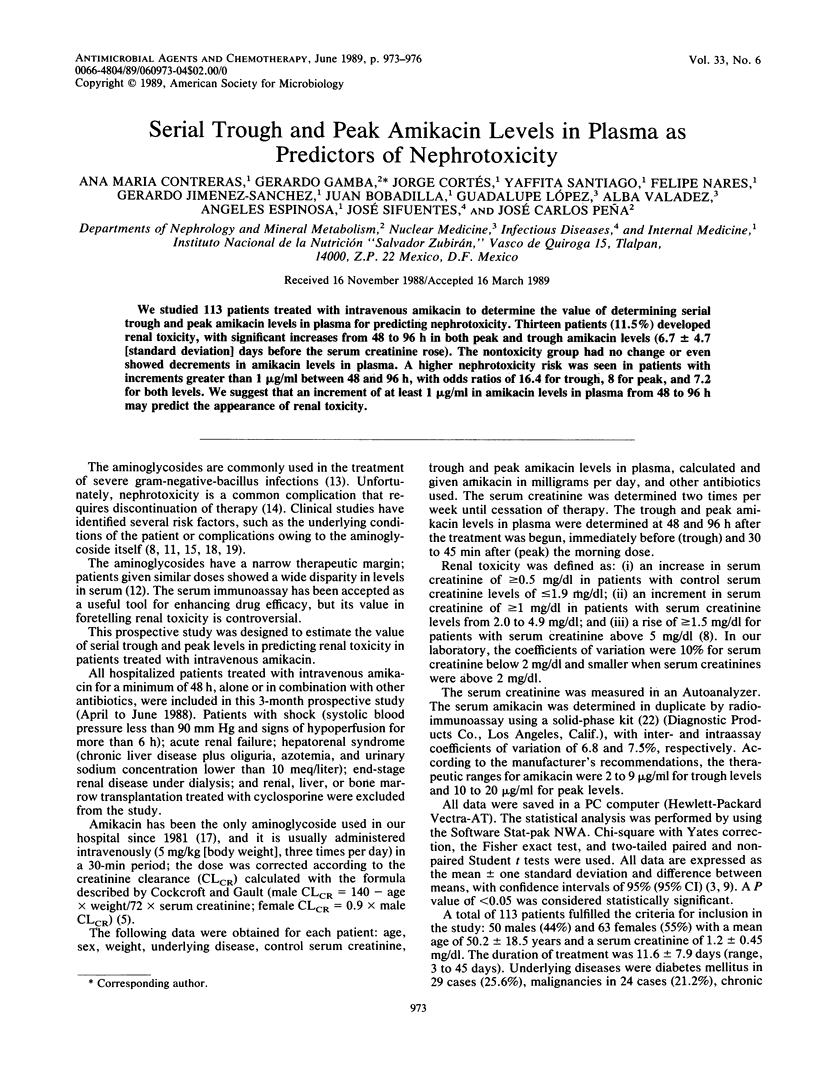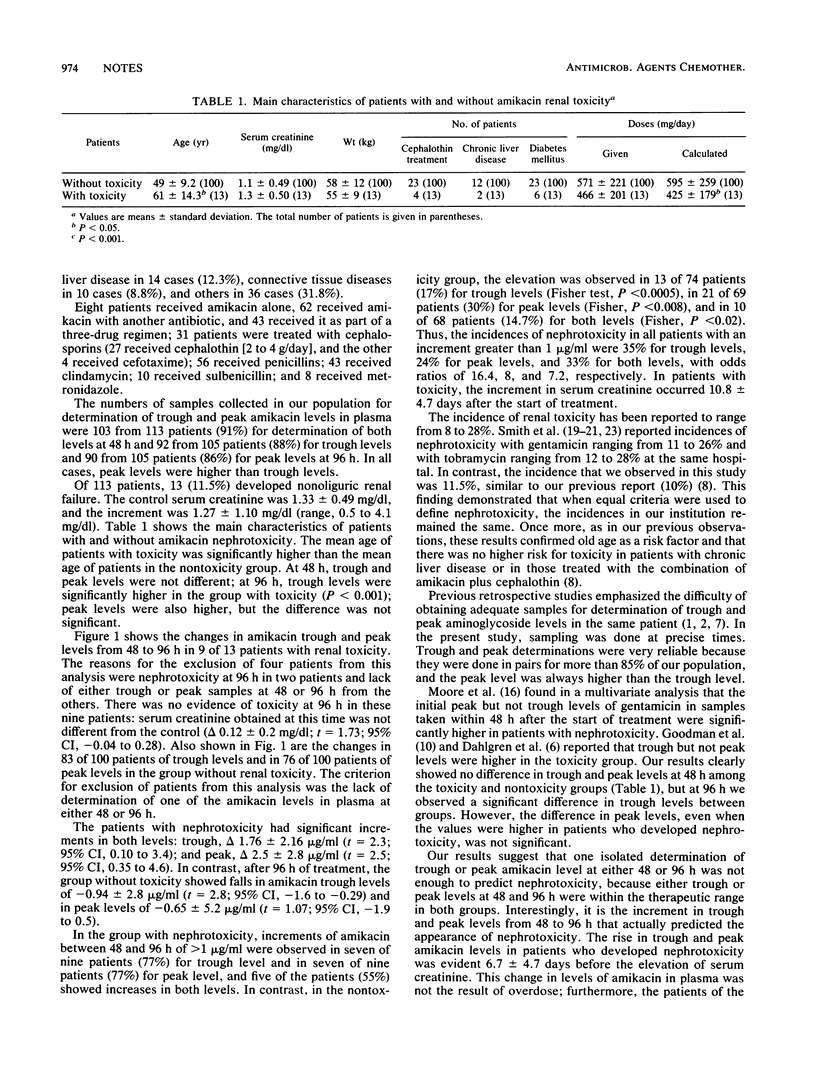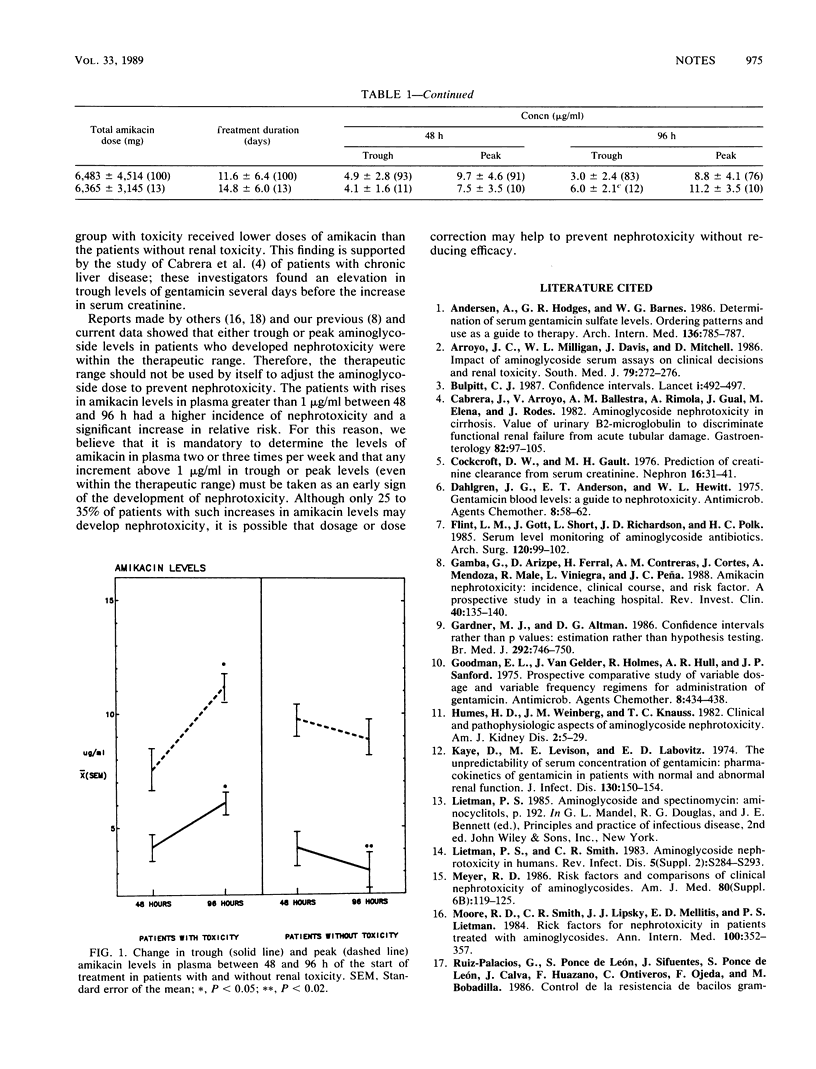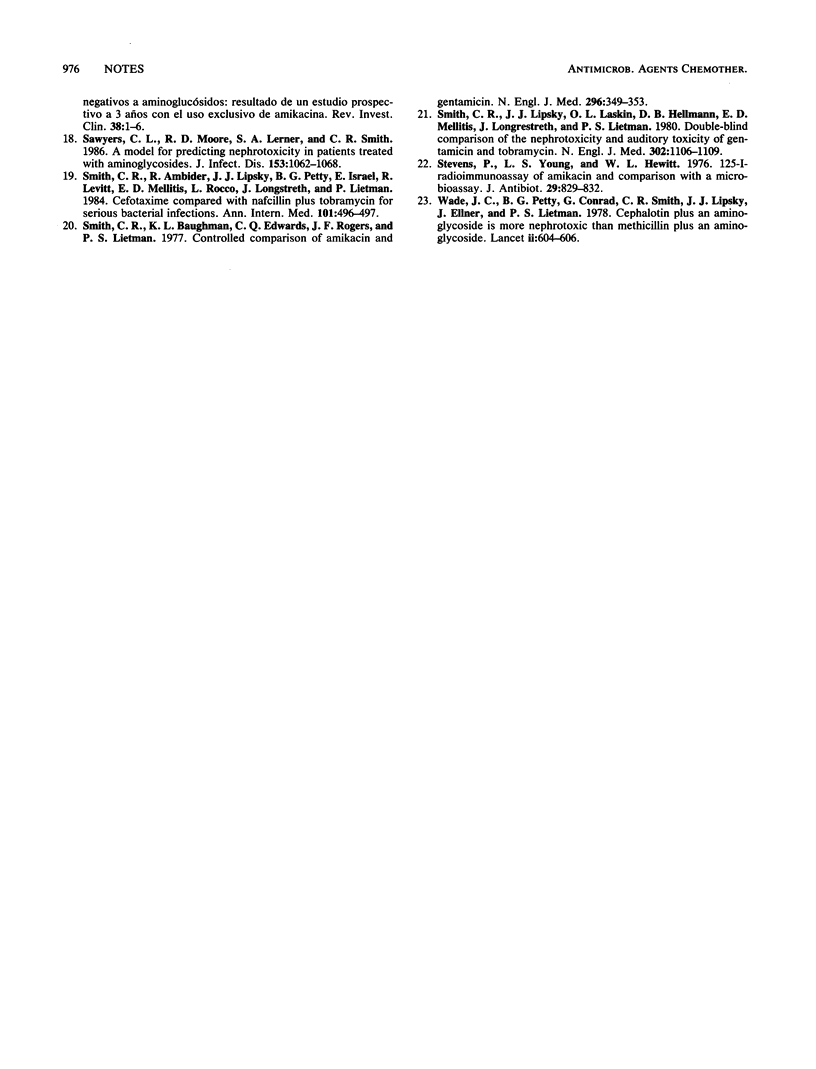Abstract
We studied 113 patients treated with intravenous amikacin to determine the value of determining serial trough and peak amikacin levels in plasma for predicting nephrotoxicity. Thirteen patients (11.5%) developed renal toxicity, with significant increases from 48 to 96 h in both peak and trough amikacin levels (6.7 +/- 4.7 [standard deviation] days before the serum creatinine rose). The nontoxicity group had no change or even showed decrements in amikacin levels in plasma. A higher nephrotoxicity risk was seen in patients with increments greater than 1 microgram/ml between 48 and 96 h, with odds ratios of 16.4 for trough, 8 for peak, and 7.2 for both levels. We suggest that an increment of at least 1 microgram/ml in amikacin levels in plasma from 48 to 96 h may predict the appearance of renal toxicity.
Full text
PDF



Selected References
These references are in PubMed. This may not be the complete list of references from this article.
- Anderson A. C., Hodges G. R., Barnes W. G. Determination of serum gentamicin sulfate levels: ordering patterns and use as a guide to therapy. Arch Intern Med. 1976 Jul;136(7):785–787. [PubMed] [Google Scholar]
- Arroyo J. C., Milligan W. L., Davis J., Mitchell D. Impact of aminoglycoside serum assays on clinical decisions and renal toxicity. South Med J. 1986 Mar;79(3):272–276. doi: 10.1097/00007611-198603000-00003. [DOI] [PubMed] [Google Scholar]
- Bulpitt C. J. Confidence intervals. Lancet. 1987 Feb 28;1(8531):494–497. doi: 10.1016/s0140-6736(87)92100-3. [DOI] [PubMed] [Google Scholar]
- Cabrera J., Arroyo V., Ballesta A. M., Rimola A., Gual J., Elena M., Rodes J. Aminoglycoside nephrotoxicity in cirrhosis. Value of urinary beta 2-microglobulin to discriminate functional renal failure from acute tubular damage. Gastroenterology. 1982 Jan;82(1):97–105. [PubMed] [Google Scholar]
- Cockcroft D. W., Gault M. H. Prediction of creatinine clearance from serum creatinine. Nephron. 1976;16(1):31–41. doi: 10.1159/000180580. [DOI] [PubMed] [Google Scholar]
- Dahlgren J. G., Anderson E. T., Hewitt W. L. Gentamicin blood levels: a guide to nephrotoxicity. Antimicrob Agents Chemother. 1975 Jul;8(1):58–62. doi: 10.1128/aac.8.1.58. [DOI] [PMC free article] [PubMed] [Google Scholar]
- Flint L. M., Gott J., Short L., Richardson J. D., Polk H. C., Jr Serum level monitoring of aminoglycoside antibiotics. Limitations in intensive care unit-related bacterial pneumonia. Arch Surg. 1985 Jan;120(1):99–103. doi: 10.1001/archsurg.1985.01390250087014. [DOI] [PubMed] [Google Scholar]
- Gamba G., Arizpe D., Ferral H., Contreras A. M., Cortés J., Mendoza A., Malé R., Viniegra L., Peña J. C. Amikacin nephrotoxicity. Incidence, clinical course and risk factors. A prospective study in a teaching hospital. Rev Invest Clin. 1988 Apr-Jun;40(2):135–140. [PubMed] [Google Scholar]
- Gardner M. J., Altman D. G. Confidence intervals rather than P values: estimation rather than hypothesis testing. Br Med J (Clin Res Ed) 1986 Mar 15;292(6522):746–750. doi: 10.1136/bmj.292.6522.746. [DOI] [PMC free article] [PubMed] [Google Scholar]
- Goodman E. L., Van Gelder J., Holmes R., Hull A. R., Sanford J. P. Prospective comparative study of variable dosage and variable frequency regimens for administration of gentamicin. Antimicrob Agents Chemother. 1975 Oct;8(4):434–438. doi: 10.1128/aac.8.4.434. [DOI] [PMC free article] [PubMed] [Google Scholar]
- Humes H. D., Weinberg J. M., Knauss T. C. Clinical and pathophysiologic aspects of aminoglycoside nephrotoxicity. Am J Kidney Dis. 1982 Jul;2(1):5–29. doi: 10.1016/s0272-6386(82)80039-5. [DOI] [PubMed] [Google Scholar]
- Kaye D., Levison M. E., Labovitz E. D. The unpredictability of serum concentrations of gentamicin: pharmacokinetics of gentamicin in patients with normal and abnormal renal function. J Infect Dis. 1974 Aug;130(2):150–154. doi: 10.1093/infdis/130.2.150. [DOI] [PubMed] [Google Scholar]
- Meyer R. D. Risk factors and comparisons of clinical nephrotoxicity of aminoglycosides. Am J Med. 1986 Jun 30;80(6B):119–125. doi: 10.1016/0002-9343(86)90489-4. [DOI] [PubMed] [Google Scholar]
- Moore R. D., Smith C. R., Lipsky J. J., Mellits E. D., Lietman P. S. Risk factors for nephrotoxicity in patients treated with aminoglycosides. Ann Intern Med. 1984 Mar;100(3):352–357. doi: 10.7326/0003-4819-100-3-352. [DOI] [PubMed] [Google Scholar]
- Sawyers C. L., Moore R. D., Lerner S. A., Smith C. R. A model for predicting nephrotoxicity in patients treated with aminoglycosides. J Infect Dis. 1986 Jun;153(6):1062–1068. doi: 10.1093/infdis/153.6.1062. [DOI] [PubMed] [Google Scholar]
- Smith C. R., Baughman K. L., Edwards C. Q., Rogers J. F., Lietman P. S. Controlled comparison of amikacin and gentamicin. N Engl J Med. 1977 Feb 17;296(7):349–353. doi: 10.1056/NEJM197702172960701. [DOI] [PubMed] [Google Scholar]
- Smith C. R., Lipsky J. J., Laskin O. L., Hellmann D. B., Mellits E. D., Longstreth J., Lietman P. S. Double-blind comparison of the nephrotoxicity and auditory toxicity of gentamicin and tobramycin. N Engl J Med. 1980 May 15;302(20):1106–1109. doi: 10.1056/NEJM198005153022002. [DOI] [PubMed] [Google Scholar]
- Stevens P., Young L. S., Hewitt W. L. 125I-Radioimmunoassay of amikacin and comparison with a microbioassay. J Antibiot (Tokyo) 1976 Aug;29(8):829–832. doi: 10.7164/antibiotics.29.829. [DOI] [PubMed] [Google Scholar]
- Wade J. C., Smith C. R., Petty B. G., Lipsky J. J., Conrad G., Ellner J., Lietman P. S. Cephalothin plus an aminoglycoside is more nephrotoxic than methicillin plus an aminoglycoside. Lancet. 1978 Sep 16;2(8090):604–606. doi: 10.1016/s0140-6736(78)92825-8. [DOI] [PubMed] [Google Scholar]


